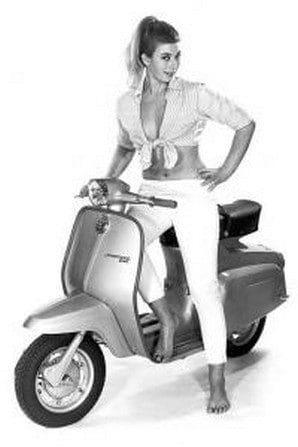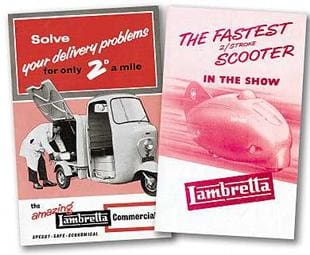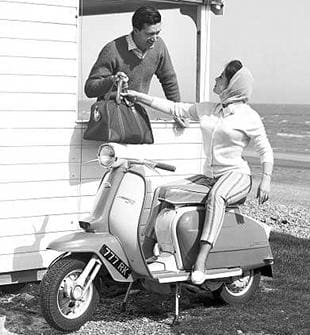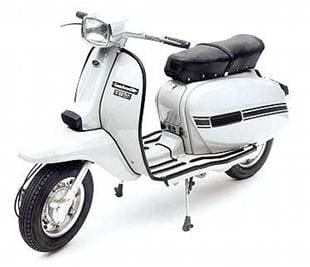
L300 1932-c1948/50 Russia
DKW 294/346cc two-stroke clones built in quantity, many for military use. Also ohv 348cc single. Never seen one but, considering numbers built, survivors must exist.
Labor 1908-60 France
Intermittent production commencing with 300/350cc singles by Courbevoie firm which became part of Alcyon group. Later production included 98-248cc two-strokes and, c1954, 175/250cc ohc singles as well as mopeds. Occasionally two-stroke survivors surface.
Ladetto 1923-32 Italy
Factory founded in Turin by brothers Emilio and Giovanni Ladetto to build simple, lightweight two-stroke commuters. Angelo Blatto joined the brothers in 1927, helping to design new models including 173/250cc side-valve singles and a potent 173cc ohv single, marketed as the Ladetto and Blatto, which was a race winner in the hands of Alfredo Panella. Blatto split from the brothers in 1930. The ohv single is sought after.
 Lady 1925-38 Belgium
Lady 1925-38 Belgium
Well made machines using proprietary engines, including Villiers, MAG, JAP, Rudge and Blackburne. From 1932, rear suspension was offered on selected models.
Lafour & Nougier 1927-36 France
Assembler from Nimes who used a range of British and French proprietary engines, ranging from 100cc two-strokes to 500cc ohv four-strokes. Another unusual model to search out at Continental autojumbles which shouldn’t break the bank.
La Francaise 1936-c1955 France
Pre-war production by this Parisian maker centred around 100-350cc motorcycles, while after WWII most machines were under 250cc including an ohc single launched in 1953 and an 48cc ohv ultra-lightweight which appeared in 1948.
LAG 1921-29 Austria
Manufacture of 118/148cc cyclemotor type units and complete machines by Liesinger Motorenfabrik AG, later made 250/350cc two-stroke motorcycles.
Lagonda 1902-05 UK
Business founded by Wilbur Gunn, an American of Scottish descent who began building tricycles, then motorcycles and cars in a converted greenhouse at his Staines home, using De Dion, MMC and Minerva engines. The likelihood of finding a Lagonda motorcycle must be virtually nil but the firm did, of course, become a leading quality car maker.
Lamaudiere 1901-07 France
Classic example of why big isn’t always better. Captivated by speed, power, performance and racing, Lamaudiere of Vers installed larger and larger engines in flimsier and flimsier chassis to keep under defined weight limits, rather than tune smaller engines for more speed.
 Lambretta 1946- Italy, Spain, India…
Lambretta 1946- Italy, Spain, India…
Marketing the right product at the right time is the road to success Lambretta travelled for over 20 years. Yet it took a World War and the almost total destruction of the company’s factory to push Innocenti into the scooter world. Born in Brescia in 1891, Ferdinando Innocenti was the son of a craftsman/hardware store owner. Aged 18, Ferdinando joined his father and half brother Rosolino in the thriving family business. As a sideline, he began dealing in second-hand ferrous materials and became fascinated by tubing and fabrication with tubing. Moving to Rome to expand, his metals business plans were scuppered when his backing bank collapsed. On the rebound, Innocenti started selling tubing manufactured by Dalmine under licence from the German firm Mannesmann.
Ferdinando opened a full scale pipe distribution business, ‘Innocenti Bros’ from a warehouse in Via Porto Fluviale, Rome in 1926. His ever fertile mind led to the design and marketing of sprinkler watering systems – including one to the Vatican. Then Innocenti moved into fire-sprinklers and industrial cooling systems.
Thanks to close business links with Dalmine, Ferdinando designed a superb, safe tubular scaffolding system which was quick and easy to assemble and dismantle. With a blaze of publicity, Innocenti scaffolding was used for major repair work to the Vatican’s Sistine Chapel. Massive business expansion led to a new Innocenti Bros factory in the Lambrate quarter of Milan in 1933. Sports stands at stadiums, electricity pylons, marquees, gas bottles, vehicle parts… and much more, all were made from extruded piping.
Military demands before WWII led to work starting on a huge new factory in 1939, but the site was of immense military importance to Italy and was bombed. On the return to peacetime, Innocenti Bros needed rebuilt premises and new products to replace military contracts. Cheap transport seemed the answer, leading to meetings with Corradino d’Ascanio. There was a proliferation of lightweight motorcycles but the duo saw a market for motor scooters.
Then the pair disagreed, d’Ascanio went to Piaggio while Ferdinando teamed up with colleague Giuseppe Lauro and engineer Pierluigi Torre to develop the ‘motor scooter for Italy.’ It was ready for production in October 1947, by which time Piaggio’s Vespa had been on the market for over a year with promising sales.
Launched as the 125M, which soon became known as the model A, it had an exposed 123cc almost upright two-stroke engine with Dell’Orto carburettor, foot operated three speed gearbox, shaft drive, tiny seven inch wheels and a pressed steel chassis with twin tubular steel rear section. At 40-44mph, it was faster than Piaggio’s 98cc Vespa. An active marketing campaign including radio promotion led to a first year production of 9669. Given bigger eight inch wheels, twistgrip gearchange and uprated suspension, the A became the 125B in November 1948. Still naked, over 35,000 were sold in 18 months.
 Fired with success, Innocenti revised the chassis to a single tube wrapped around the engine/fuel tank and for seat/s mounting. Offered initially as the naked model 125C in February 1950 it was joined two months later by the 125LC (Lusso C) with full enclosure and fan cooling. In less than two years the Lambrate factory built 87,500 Cs and 42,500 LCs robbing sales from Vespa, who hit back by enlarging their engine to 125cc. Daggers were drawn.
Fired with success, Innocenti revised the chassis to a single tube wrapped around the engine/fuel tank and for seat/s mounting. Offered initially as the naked model 125C in February 1950 it was joined two months later by the 125LC (Lusso C) with full enclosure and fan cooling. In less than two years the Lambrate factory built 87,500 Cs and 42,500 LCs robbing sales from Vespa, who hit back by enlarging their engine to 125cc. Daggers were drawn.
Continuing their policy of regular model upgrades, Lambretta gave the range a facelift with redesigned frame and front fork enclosure, revised rear suspension with engine hung from pivot links controlled by a single shock absorber and more power. Offered as the D125/ LD125 (1951-56), it was then given an engine enlargement to become the D150/LD150 (1954-57). A cut price E (Economico) with another revised frame and pull start appeared in 1953 followed by the F with kick starter a year later. Electric start became an option on the LD series in 1954. Lambrate built a staggering 667,076 Ds, LDs and derivatives in six years.
Lambrate rush-launched the 170cc TV175 (Turismo Veloce) in September 1957. With four speed gearbox, 10 inch wheels, restyled bodywork, enclosed duplex chain final drive and more it should have swept the field. The design and timing were right but it was unreliable, underdeveloped and dented the Lambretta image.
Innocenti carried the TV175 Series 1 stigma for the next few years. But they learnt from their mistakes. The next new model featured TV175 style but housed a completely new horizontal engine, which proved brilliant. Coded Li125/Li150 Series 1, they were the machines on which many models were based until scooter production at the Italian factory ended in 1971. A hot seller, production of these machines comprised 143,790/18 months for Series 1 Li and 273,127/2 years Series 2 with handlebar mounted headlight (instead of apron mounting) plus revised carburation and gear ratios.
Damage limitation saw Lambretta rush through a rapid redesign of the 175TV. Its new engine and running gear was based on the successful Li, although the general 175TV bodywork was retained but updated. In keeping with early Sixties popular fashion, Lambretta, with typical Italian style, went thin with their Series 3 Li and TV Slimlines. Sadly, worldwide scooter sales were in decline. For many manufacturers to have sold 290,000 Li Series 3 scooters in six years would have been good, but for Innocenti it was a body blow.
Specials to boost sales – including a 200cc version of the TV, Li Special, Li Special Pacemaker, 200 Special X – appeared and Innocenti began making small scooters including the Lambretta 50, Cento J50 (20/1)/J98/J125/J125 Star-Stream, all with steel monocoque chassis, upright engine, chain final drive and three-speed gearbox except for the export model Star-Stream which had another cog. In 1968, many fans felt Innocenti had lost the plot on launch of the Bertine designed Luna Series; Lui 50, Cometa 75 and Vega 75. To some they were a style accessory; to others an insult to the Lambretta name. Beauty is in the eye of the beholder.
Finally in 1969 came the Deluxe Series coded DL125, 150 and 200 which were updated Li Series models aimed more at economy than style. Lambretta was in decline. Ferdinando Innocenti died in June 1966 and despite other enterprises the firm wanted no more of scooters, ending production in 1971. All manufacturing equipment and rights for the DL Series were sold to Scooters India where the name lives on.
Lambretta Locomociones SA (Serveta Lambrettas) was established at Eibar, near Bilbao, Spain in 1952 to first market and from 1954 to produce, under Lambrate guidance, selected Lambrettas. And Innocenti products were built under licence round much of the world: France-Societe Industrielle de Troyes-LC125, Germany-NSU-LD125/150, Argentine-Siambretta-many models in Fifties/Sixties. Then Innocenti built German Goggomobil cars under licence in Venezuela with government help, were involved in many industrial projects in the Americas, built Austin A40 cars under licence in Italy…
The story continues. Mopeds and cyclemotors proved steady sellers while scooter-based light commercial vehicles sold in big numbers. Early models like the 125FB carried loads in front of the rider/driver while later models including the 150FD and Lambro models, boasted a driver’s cabin, behind which loads were carried.
Due to company promotional policy, combined with period fashion, Lambrettas became and still are a style statement. Rallied, raced, sprinted, trialed, stripped, loaded, modified to fashion accessory, Lambretta scooters have done the lot.
 But they never made a motorcycle? Well one never went into quantity production. During the late 1940s/early 1950s Lambretta came up with an exquisite V-twin, shaft drive 250cc dohc racing motorcycle which although apparently competitive, saw limited action. Folklore claims Lambretta were incensed by Italian motorcycle factories considering making scooters and the cracking little racer was a warning ‘we can make motorcycles too, and good ones at that! Keep to what you do and so will we.’ Fact or fiction? Who knows, but the thought conjures up a delightful image of big business intrigue. One in red survives in Lambretta museum in Italy.
But they never made a motorcycle? Well one never went into quantity production. During the late 1940s/early 1950s Lambretta came up with an exquisite V-twin, shaft drive 250cc dohc racing motorcycle which although apparently competitive, saw limited action. Folklore claims Lambretta were incensed by Italian motorcycle factories considering making scooters and the cracking little racer was a warning ‘we can make motorcycles too, and good ones at that! Keep to what you do and so will we.’ Fact or fiction? Who knows, but the thought conjures up a delightful image of big business intrigue. One in red survives in Lambretta museum in Italy.
Backed by a superb club network throughout much of the world, excellent magazines led by Scootering from Mortons Media Group, scooter culture, good spares situation, enthusiastic expert help and engineering, the classic Lambretta future looks in good shape. Reliable and durable, Lambrettas make good entry level machines to the scooter world and are eagerly sought by the seasoned enthusiast too.


